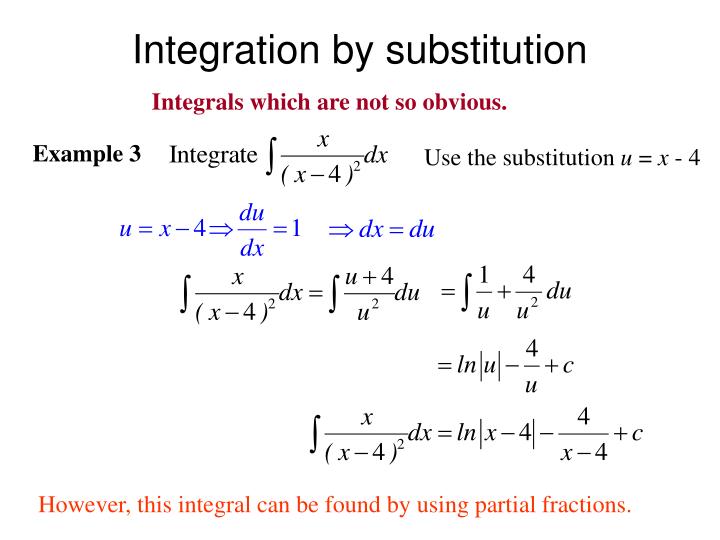
However, even with integration by parts taken together the two substitutions must completely replace the original variable, with no leftovers allowed. In that case, you do two u-substitutions (but you call them by different variables). It isn't really an exception, but you can sort of have leftover bits when you do integration by parts.

∫ cos (x²) dx is nightmarishly difficult (getting into something called Fresnel integrals). ∫ (x)∙cos(x²) dx is very easy to integrate but the very similar looking

With integration, being close to a standard form is not good enough: you must have an exact match. So, the answer is, no, you cannot do u-substitution that way. And remember du is the derivative of whatever you called u, it is NOT just some notation.
#U SUB INTEGRATION HOW TO#
Where f(u) du is something you know how to integrate. The purpose of u substitution is to wind up with ∫ f(u) du A valid substitution, generally speaking, requires that ALL references to the original variable be replaced ESPECIALLY including its dx (or whatever the variable is).

Run More Threads and so on.Sorry, that is ordinarily not a valid means of substitution. If That's wrong, just create another parallel process. Verify that by another parallel process like 4096*12 which is 480000+1200-48 which is probably 481152. For Some Reason, 42*6, can be rewritten as 36*7, faster than multiplying 6*7, because parallel processes were "strong as a carbon atom". If You don't run enough parallel processes, you might not find the quickest solution. Running parallel processes in Math is the Best Part of ADHD and Autism, and it finds out more information when connecting the dots gets connected.

I'd think of something like x=y^5-5cy^3+5cy You put in the limits, it isn't as ready for running parallel processes. If You're dealing with a+b, rather have a^5+b^5 or (a+b)^5 be ready. With Polynomials and cubic and quintic equations more shortcuts are ready, since (a+b)^5=a^5+b^5+5ab(a+b)^3+5ab(a+b), and One can use it more if the have a quintic nested cubic or vice versa, when doing crazy stuff with diffEQ and regression to a smaller diffEQ that's easier. ∫ 1 2 2 x ( x 2 + 1 ) 3 d x = ∫ 2 5 ( u ) 3 d u \displaystyle\int_ ∫ 1 2 2 x ( x 2 + 1 ) 3 d x = ∫ 2 5 ( u ) 3 d u integral, start subscript, start color #ca337c, 1, end color #ca337c, end subscript, start superscript, start color #ca337c, 2, end color #ca337c, end superscript, start color #7854ab, 2, x, end color #7854ab, start color #e07d10, left parenthesis, end color #e07d10, start color #1fab54, x, squared, plus, 1, end color #1fab54, start color #e07d10, right parenthesis, cubed, end color #e07d10, start color #7854ab, d, x, end color #7854ab, equals, integral, start subscript, start color #ca337c, 2, end color #ca337c, end subscript, start superscript, start color #ca337c, 5, end color #ca337c, end superscript, start color #e07d10, left parenthesis, end color #e07d10, start color #1fab54, u, end color #1fab54, start color #e07d10, right parenthesis, cubed, end color #e07d10, start color #7854ab, d, u, end color #7854abĮxactly.


 0 kommentar(er)
0 kommentar(er)
